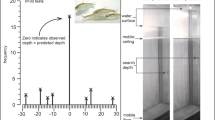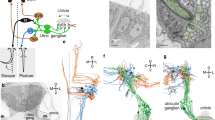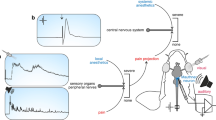Abstract
Rheotaxis is a behavioural orientation to water currents1. It has been demonstrated physiologically that some lateral-line receptors are particularly well suited to provide information on water currents2, but their contribution to rheotaxis has been largely overlooked. The accepted view is that rheotaxis is mediated by visual and tactile cues1, and that in rheotactic orientation “the lateral lines play only a minor role”3. Here we provide a direct demonstration that rheotaxis can be mediated by the lateral line, and indeed by one specific receptor class of this system. In three diverse fish species, pharmacological block of the entire lateral-line system substantially increases the velocity threshold for rheotactic behaviour. The same effect is observed when only superficial neuromasts are ablated, whereas blockade of the other receptor class, canal neuromasts, has no such effect. Our results therefore demonstrate that superficial neuromasts make an important contribution to rheotactic behaviour in fish.
This is a preview of subscription content, access via your institution
Access options
Subscribe to this journal
Receive 51 print issues and online access
$199.00 per year
only $3.90 per issue
Buy this article
- Purchase on Springer Link
- Instant access to full article PDF
Prices may be subject to local taxes which are calculated during checkout



Similar content being viewed by others
References
Arnold, G. P. Rheotrophism in fishes. Biol. Rev. 49, 515–576 (1974).
Münz, H. in The Mechanosensory Lateral Line Neurobiology and Evolution (eds Coombs, S., Gorner, P. & Münz, H.) 285–298 (Springer, New York, (1989)).
Dijkgraaf, S. in The Mechanosensory Lateral Line Neurobiology and Evolution (eds Coombs, S., Gorner, P. & Münz, H.)7–14 (Springer, New York, (1989)).
Montgomery, J. C., Coombs, S. & Halstead, M. Biology of the mechanosensory lateral line in fishes. Rev. Fish Biol. Fish. 5, 399–416 (1995).
Coombs, S. & Montgomery, J. C. Function and evolution of superficial neuromasts in an antarctic notothenioid fish. Brain Behav. Evol. 44, 287–298 (1994).
Montgomery, J. C. & Milton, R. C. Use of the lateral line for feeding in the Torrent fish (Cheimarrichthys fosteri). N Z J. Zool. 20, 121–125 (1993).
Montgomery, J. C. & Macdonald, J. A. Sensory tuning of lateral line receptors in Antarctic fish to the movements of planktonic prey. Science 235, 195–196 (1987).
Abdel-Latif, H., Hassan, E. S. & von Campenhausen, C. Sensory performance of blind Mexican cave fish after destruction of the canal neuromasts. Naturwissenschaften 77, 237–239 (1990).
Karlsen, H. E. & Sand, O. Selective and reversible blocking of the lateral line in freshwater fish. J. Exp. Biol. 133, 249–262 (1987).
Kroese, A. B. A. & van den Bercken, J. Effects of ototoxic antibiotics on sensory hair cell functioning. Hearing Res. 6, 183–197 (1982).
Song, J., Yan, H. Y. & Popper, A. N. Damage and recovery of hair cells in fish canal (but not superficial) neuromasts after gentamicin exposure. Hear. Res. 91, 63–71 (1995).
Montgomery, J. C. & Pankhurst, N. W. in Deep-sea Fish (eds Randall, D. J. & Farrell, A. P.) 325–349 (Academic, San Diego, (1997)).
Able, K. P. & Able, M. A. Interactions in the flexible orientation system of a migratory bird. Nature 375, 230–232 (1995).
Baxter, J. H. S. & Fuiman, L. A. in The Mechanosensory Lateral Line Neurobiology and Evolution (eds Coombs, S., Gorner, P. & Münz, H.) 481–499 (Springer, New York, (1989)).
Andriashev, A. P. & Jakubowski, M. Morphological grounds for generic separation of the Antarctic broadhead-fishes (Trematomus borchgrevinki) Boulenger and T. brachysoma Pappenheim) and a new status of the genus Pagothenia Nichols et Lamonte (Nototheniidae). Zool. Zh. 50, 1041–1055 (1971).
Schemmel, C. Vergleichende Untersuchungen an den Hautsinnesorganen ober- und unterirdisch lebender Astyanax-Formen ein Beitrag zur Evolution der Cavernicolen. Z. Morphol. Tiere 61, 255–316 (1967).
Acknowledgements
We thank the Marsden Fund for support, Kelly Tarlton's Underwater World for an Antarctic scholarship and Carol Diebel for at times acting in loco mentoris.
Author information
Authors and Affiliations
Corresponding author
Rights and permissions
About this article
Cite this article
Montgomery, J., Baker, C. & Carton, A. The lateral line can mediate rheotaxis in fish. Nature 389, 960–963 (1997). https://doi.org/10.1038/40135
Received:
Accepted:
Issue Date:
DOI: https://doi.org/10.1038/40135
This article is cited by
-
Sit and survive: predation avoidance by cryptobenthic coral reef fishes
Marine Biology (2024)
-
An optofluidic platform for interrogating chemosensory behavior and brainwide neural representation in larval zebrafish
Nature Communications (2023)
-
Highly sensitive and broadband meta-mechanoreceptor via mechanical frequency-division multiplexing
Nature Communications (2023)
-
Lateral line ablation by ototoxic compounds results in distinct rheotaxis profiles in larval zebrafish
Communications Biology (2023)
-
Analysis of negative phototaxis in the pill bug (Armadillidium vulgare) using omnidirectional servosphere
Artificial Life and Robotics (2023)
Comments
By submitting a comment you agree to abide by our Terms and Community Guidelines. If you find something abusive or that does not comply with our terms or guidelines please flag it as inappropriate.



